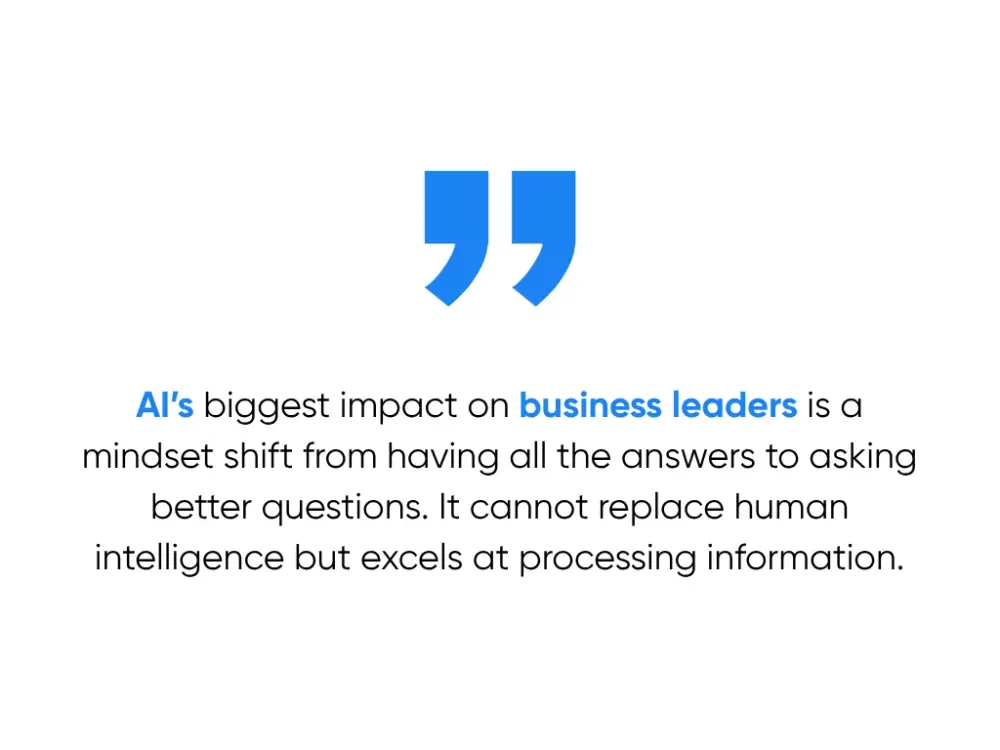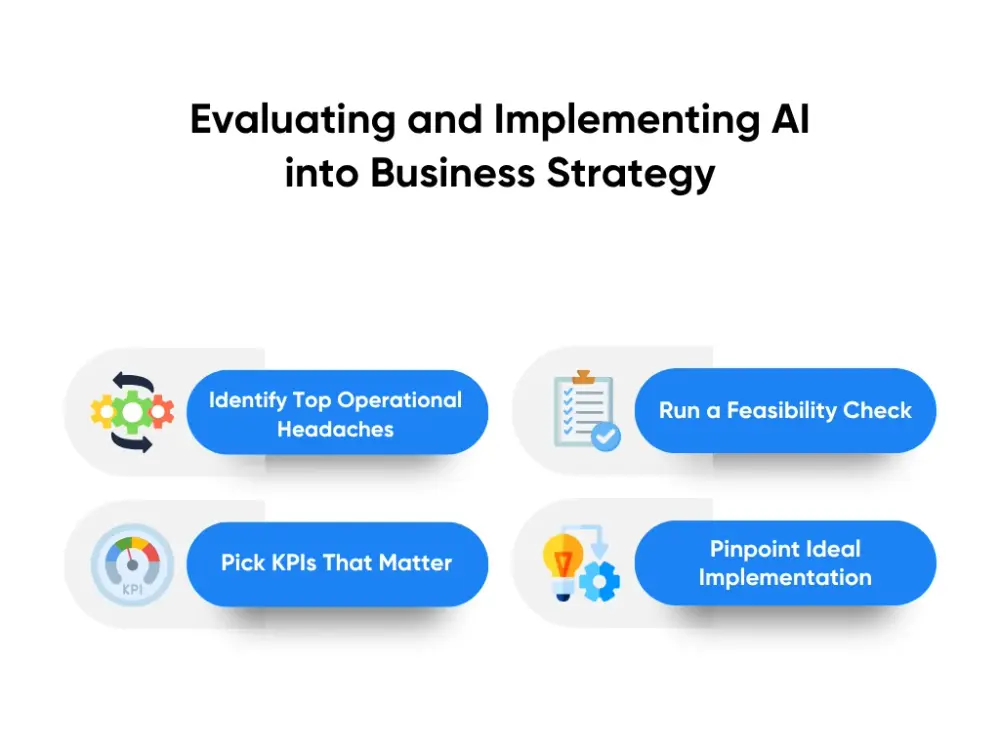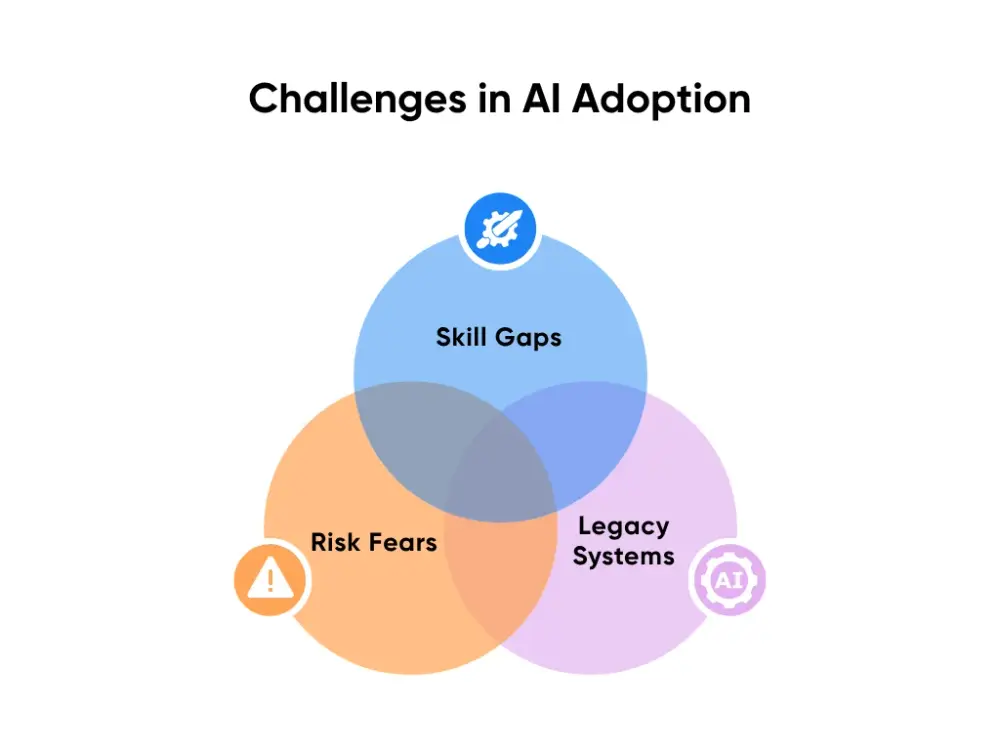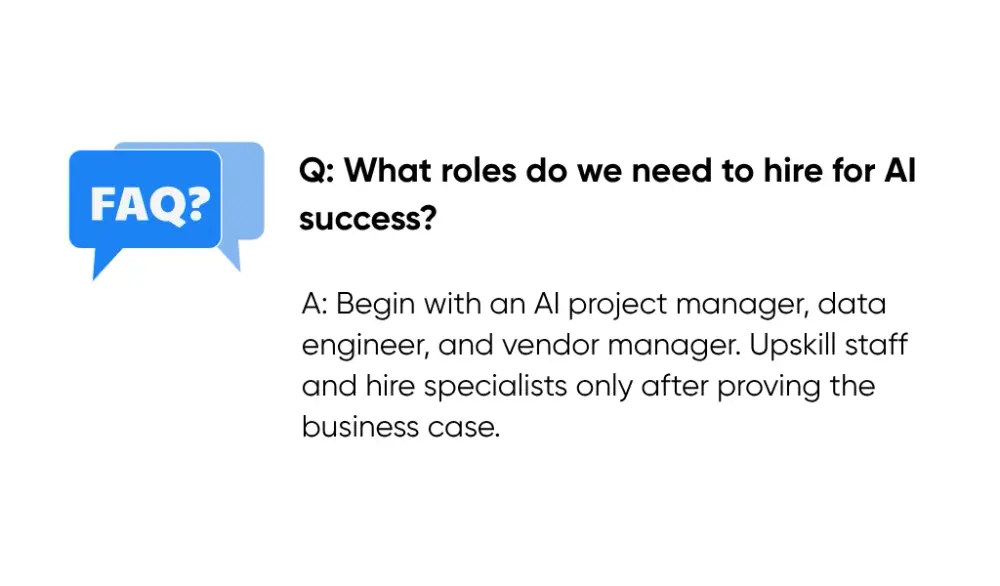AI for Business Leaders: How to Drive Strategic Impact in 2025

Chris Raroque
Co-Founder

Share to AI
Ask AI to summarize and analyze this article. Click any AI platform below to open with a pre-filled prompt.
It’s 2025. Every tech vendor is probably promising that AI will revolutionize your business. But here is something they might not be telling you: I burned through $1,200 in AI API costs in a single month while developing features for an app that charges users $10/month. The reality of AI for business leaders is that beyond the hype lies a maze of hidden costs, failed experiments, and hard-won lessons that most learn too late.
Aloa helps business leaders navigate these exact challenges, turning AI confusion into practical implementation. We know exactly what creates real business value, and what's just expensive noise.
In this guide, I’ll share:
- How leadership should change around AI
- Practical ways to evaluate what’s worth building
- Deployment tactics that actually work
- How to use AI to take decision-making to the next level
- Solutions to inevitable adoption challenges
I learned these lessons the hard way, while hitting every wall possible on my journey to ship my first major AI feature. Let’s go through what would have saved me thousands of dollars and months of frustration.
Unlocking Leadership Potential in the AI Age

The biggest impact of AI for business leaders is a revolutionary mindset shift: instead of having to be the person with all the answers, you simply have to be the person asking better questions. Artificial intelligence isn’t going to replace your brain, but it’s very good at information processing.
Think about it: AI can analyze patterns across millions of data points while you're still reading the executive summary. Leaders don’t have to compete with that.
Instead, your role shifts to directing it, interpreting its analysis, and applying human judgment where machine intelligence falls short. Learning AI is less about being the chess master moving pieces, but rather about being a coach who develops players who can make smart moves independently.
Here’s what successful AI leaders actually do differently:
- Get their hands dirty: They use the tools themselves and understand the limitations firsthand.
- Create a learning culture: Failed experiments turn into learning opportunities, not career-ending mistakes.
- Bridge tech and business: The best AI leaders understand how data science algorithms relate to business outcomes. They can explain why a 95% accuracy rate might still be terrible for a specific use case, or why that flashy AI demo won't scale.
Evaluating and Implementing AI into Business Strategy

Like many other developers, I’ve also fallen victim to shiny object syndrome. Months wasted perfecting features nobody needed, while obvious problems went unsolved. Here's how to avoid that trap.
Find Your Biggest Operational Headaches
I've seen decisions get delayed for weeks because data lives in five different systems. Operational inefficiencies create more mind-numbing busywork than is necessary, especially if you have customer touchpoints that require manual handoffs between departments, force customers to repeat information multiple times, or take days to resolve simple requests.
Hone in on these friction points and try to quantify what you need to invest to smooth them over. If you can't put a dollar figure or time cost on the problem, it's not ready for AI.
Run a Feasibility Check
Before starting any AI project, I ask myself these three questions:
- Do I actually have the data? No data means no AI. Period. And I mean quality data that's actually accessible, not some theoretical dataset locked in a warehouse somewhere.
- How complex is the solution? If it takes six months and a team of PhDs to build, you're probably overengineering it. The best AI implementations are embarrassingly simple.
- Will people actually use it? I've seen technically perfect AI solutions fail because nobody asked the end users what they actually needed. If it doesn't make someone's job easier, it's dead on arrival.
Pick KPIs That Matter
This is where most people mess up. They get excited about "AI adoption rate" or "models deployed" or other metrics that sound impressive in presentations but mean nothing to your CFO.
Pick metrics that directly tie to money, such as:
- Revenue per employee
- Customer acquisition cost
- Processing time
- Error rates
If the AI reduces invoice processing from 3 days to 30 minutes, that's a real difference. If it cuts customer churn by 15%, that's real. Everything else is just expensive experimentation.
Google found that companies obsessing over business metrics (not fancy AI accuracy scores) actually make money. Makes sense, right? MIT’s research backs this up, showing that organizations that let AI help them discover new KPIs (not just track old ones) see better ROI.
Find Your Implementation Sweet Spot
I've watched too many companies burn millions trying to build proprietary AI from scratch when a $50/month tool would've solved their problem. Start small, prove the value, then use those wins to fund the bigger bets. Nobody's going to give you budget for your moonshot if you can't show them a working prototype first.
The projects that actually ship have three things in common:
- Solve one specific problem: Not "transform our entire customer journey" but "auto-categorize support tickets"
- Use existing tools: No custom generative AI models, no fancy algorithms, just proven solutions applied to your data
- Show results fast: If you can't prove value in 3-6 months, you'll lose momentum and budget
The next time you see a competitor launch some flashy AI feature, don’t panic. You don’t have to AI-ify everything. Just fix the processes that are bleeding money. Salesforce says the same thing: successful companies narrow down to projects that can be implemented in less than 6 months with off-the-shelf AI solutions and minimal data cleanup.
Practical Tactics for Successful AI Deployment

Here's what actually works when deploying AI, based on my personal experience with projects that have been successfully shipped.
Fix Your Infrastructure Before You Build Anything
Before writing any code or signing any contracts, audit your tech stack. Can your systems handle 10x the API calls? Is your data actually accessible, or is it locked in some legacy system from 2003?
I've seen projects fail because no one checked if the existing infrastructure could handle AI workloads.
It's like trying to run a Ferrari engine in a golf cart. Doesn't matter how fancy your AI is if your servers can't handle it.
Get the Right People in the Room
In order for a new AI initiative to take off effectively, you should make up a team with people who can actually make decisions. Your data person, your tech person, your people person, etc. You’ll need those who actually run things day-to-day.
Otherwise, it’s just another pointless committee calling meetings.
Phase Your Rollouts
No one can actually predict how AI implementation will go or how your team will use it. I've learned to stop trying to plan for every scenario and just accept that users will break things in ways you never imagined.
Instead, pick 2-3 people who actually want to try new stuff. Let them play with it first, give suggestions, test out the ideal flow, and become your internal advocates. Once they see real benefits and can demonstrate how it works, you can then expand it to the rest of your team.
Monitor Everything
Set up monitoring from day one, and track everything: usage patterns, error rates, and actual business impact. Not just "is it working?" but "is anyone actually using this?" and "is it saving us money?"
Keep a close eye on API usage and pricing changes too. AI providers can slap on usage caps overnight or release a newer model that completely breaks your existing workflow. I've seen companies get surprised by bills that jumped 300% because they didn't notice a pricing change, or have features stop working because the model they built on isn’t a priority anymore.
These tips will keep you from burning money in the dark.
Mastering Advanced Decision-Making with AI

AI is meant to make your decisions better, not make decisions for you. Here’s how you can best use it:
Position Yourself as the Ultimate Arbiter
Here’s a real-life example: When I use AI to timebox my day, it analyzes task priorities, deadlines, and even suggests optimal schedules. That’s what AI is best at. But I can still decide whether I want an important call to happen before or after my coffee kicks in. I always build off of the AI output rather than taking it as is.
Build Decision Frameworks That Play to AI's Strengths
Let AI handle data aggregation, pattern recognition, and scenario modeling. AI eliminates the noise so you can focus on interpreting results and applying judgment. For instance, when evaluating whether to expand to a new market, I'll have AI crunch competitor data, demographic trends, and market saturation metrics from dozens of sources.
AI spots patterns I'd miss, like how similar markets performed after certain regulatory changes. But I'm the one who decides if those patterns matter for our specific situation, considering factors AI can't quantify like team morale or strategic timing.
Start With Reversible Decisions to Build Confidence
Use AI for applications that you can easily backpedal on. These include pricing optimization, marketing personalization, or customer service routing before betting the company on its recommendations.
I learned this after almost letting AI auto-adjust our enterprise pricing based on "optimal" calculations. It wanted to raise prices by 40% because our competitors charged more, not knowing that those competitors included features we removed from our offerings to reduce bloat and improve pricing. Now I only let AI suggest pricing for new features where we have no historical data.
Overcoming Challenges in AI Adoption

Most AI initiatives fail not because the technology doesn't work, but because organizations underestimate three critical barriers. Here are the best practices to work around the most common challenges of AI adoption.
Skill Gaps
You don't need a PhD to use AI effectively. At Aloa, we've had non-technical employees build internal tools that actually work.
Sure, there are training workshops, certifications, and YouTube videos if people want to go deep. But honestly? Just get your non-technical teams talking to your engineers. Sometimes your marketing person or your customer service rep has the best ideas for AI workflows because they understand the actual problems.
The biggest wins often come from departments that aren't traditionally "technical." They see opportunities that engineers miss because they're dealing with the messy, human side of the business every day.
Legacy Systems
As we’ve established, fixing your infrastructure is essential to enabling AI support. But like with AI adoption, it’s important to pace yourself. Don’t try to fix everything at once.
Start with API-friendly tools for new initiatives while building bridges to old systems. This hybrid approach lets you show quick wins with modern tools while gradually connecting your legacy data. This lets you ease into updating your systems to be fully AI-ready.
Risk Fears
In a survey of 1,646 employees from different companies, McKinsey found that the most common fear surrounding AI adoption is a lack of clear strategy, followed by a lack of talent and tech silos. In my experience, the best response to these fears is to address them directly.
Communicate the benefits of AI, respond to concerns as they come, and most importantly, lead by example. Launch small, learn fast, scale gradually.
Key Takeaways
AI for business leaders boils down to one core rule: sensible, practical implementation. AI is powerful, but it needs to be used thoughtfully.
Start by identifying your top 3 operational pain points and calculate what they're costing you. Verify you have the data needed for AI to work. And most importantly, assign someone who truly owns the initiative and its outcomes.
Still trying to figure out where to start with AI? Aloa helps business leaders cut through the hype and implement AI solutions that actually deliver results. Having developed AI for just about every niche, from fintech to social impact, we’ve been in the trenches and know what works in production. Let us help you skip the expensive mistakes. Reach out today!
FAQs
What's the typical ROI timeline for AI projects?
AI project timelines vary dramatically between enterprises and smaller companies, so set realistic expectations based on your scale. Small companies often see returns in 3-6 months for simple automation like chatbots because they move quickly with fewer legacy constraints. Enterprises typically need 12-24 months due to complex integrations and compliance requirements.
Should we build AI in-house or buy existing solutions?
Buy for common problems (customer service chatbots, sales forecasting), build for competitive advantages (proprietary algorithms using your unique data). Most companies use a hybrid approach where they purchase foundational AI tools and customize them for their specific needs. Start with off-the-shelf solutions to learn, then build custom features as you mature.
How much should we budget for our first AI initiative?
Pilot projects typically range from $50K-$200K, including software, integration, and training. Factor in ongoing costs: cloud computing ($1K-$10K/month), model updates, and staff time. Many companies start with a small proof-of-concept under $50K to demonstrate value before larger investments.
What roles do we need to hire for AI success?

Start with an AI project manager who speaks both business and tech, a data engineer to prep your data, and someone to manage vendor relationships. Upskill existing staff for domain expertise. Only hire specialists once you've proven the business case.
How do we prevent AI from making costly mistakes?
Set clear boundaries on what AI can decide autonomously versus what needs human approval. Start with low-risk decisions (routing customer emails) before high-stakes ones (loan approvals). Implement monitoring dashboards to track accuracy and flag anomalies. Always maintain a "human in the loop" for critical decisions.
Can AI work with our legacy systems?
Yes, through APIs and middleware. You don't need to rebuild everything. Modern AI tools are designed to integrate with existing systems. Start by connecting AI to one system (like your CRM), prove value, then expand. Most successful implementations take a gradual approach rather than wholesale replacement.